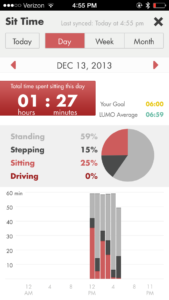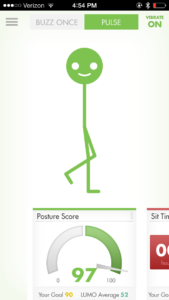Lumo Back Posture Sensor Review
Like most reviews sites, our editorial staff and laboratory testing expenses are partially offset by earning small commissions (at no cost to you) when you purchase something through those links. Learn More

Overview
| Review Summary |
The first activity tracker we’ve reviewed, the Lumo Back is a mixed bag. Its sensor does correct slouch with gentle vibration, but rarely trips for hunched workers, requiring a full-blown Quasimodo impersonation to activate. Lumo Back’s posture correction component encourages a rigid upright posture which may not be for the best. The activity tracking aspect is basic in the best way. The fact that it tracks time spent sitting, standing, and walking, making it by far the best personal quantification device we’ve seen for anyone fighting sitting disease. |
|---|---|
| Where to buy |
Buy on Amazon |
Rating
| Expert Rating | |
|---|---|
| Positives | Effective in correcting serious slouch, the only activity tracker we’d truly recommend for walking workers as it monitors time spent sitting, standing, and walking – the most important statistics for any desker. |
| Negatives | The perfectly upright seated posture that the Lumo Back encourages actually isn’t something you’ll want to maintain all day (see above for why). Not as effective for people working from a standing position. For smartphone users only. |
Bottom Line
Review
“Like Strapping your Mother to your Back”
Not really a pleasant image, but there’s definitely something maternal about the way the Lumo Back functions. It’s a small, flat sensor that users strap onto the small of their back. Once there, the Lumo Back senses deviations in posture – either backward (slouch) or forward (hunch) – and vibrates to let you know that it’s watching you and wants you to straighten up. See what we mean by maternal?
And, predictably, it will tell you to straighten up a lot. A leisurely stretch is often rewarded with a angry series of pulses until you pull yourself back up to vertical. And you will notice the buzzing – through the course of a workday, essentially every variation from ideal posture will irritate the Lumo Back, which will then irritate you. If it gets to be a little much, then you can always modify the intensity and sensitivity of the posture sensor, or just disable vibration. The upshot is a device that could be charitably described as “persistent”, but it works – largely because you can’t ignore it. Severe slouchers should welcome the Lumo Back, and it has straightened a few backs here at the office.
On the other hand, it’s not nearly as sensitive to hunch. Granted, it was designed primarily to address slouch, but we were a little disappointed to find that we had to bend nearly double before the Lumo Back noticed and corrected us. It’s also not quite as sensitive in the standing position. Sitting is one thing – even the tiniest of backwards leans will result in some buzzing, but we found that we could get away with some minor slouch while standing. So if you’re after a posture fine-tune, the Lumo Back might not be quite sensitive enough to catch you; however, those with serious, chronic slouch will still benefit.
Perennial slouchers will likely appreciate the effects on their wallets as well. The Lumo Back claims to train postural muscle memory, much in the same way that Kinesio tape or similar products do. But, it’s easier to put on, easier to take off, and vastly cheaper; one Lumo Back can mimic the effects of countless tapings.
The most serious issue with the Lumo Back is that it encourages keeping and holding one working posture. While a 90º posture certainly looks impressive, keeping it for an entire day can put some serious strain on your back. Compounding this issue is the fact that the LUMOback actively harasses you for choosing a more relaxing posture. One study claims that a 135º recline is actually more back healthy, but moving back toward this position while wearing a Lumo Back will earn you some reproving buzzes. Lumo Back responds to this study in one of their blog posts, and explains their rationale for keeping users at right angles. Like us, they recommend standing up, moving, and stretching as much as possible, but consider an upright posture ideal for long seated sessions. We would caution anyone using a Lumo Back to religiously follow advice about varying positions; sitting upright for a full day can still get you popping painkillers in a hurry.
Desker Data
 The other half of the Lumo Back package is a nifty little iPhone app (recently made available for Android 4.3 and higher as well). Once linked via Bluetooth to the Lumo Back strap, it collects data about your work habits, giving you a breakdown of slouch vs. upright time and assigning you goals to work toward. While basic, it does offer some valuable data for treadmill deskers.
The other half of the Lumo Back package is a nifty little iPhone app (recently made available for Android 4.3 and higher as well). Once linked via Bluetooth to the Lumo Back strap, it collects data about your work habits, giving you a breakdown of slouch vs. upright time and assigning you goals to work toward. While basic, it does offer some valuable data for treadmill deskers.
One of our favorite catchphrases is “your best position is your next one”. Simply put, don’t spend too much time in any one position, swap between sitting, standing, and walking as much as you can. Each position – yes, even sitting – has its positives, and all of them – yep, walking included – have their negatives. And the Lumo Back, unlike any other activity tracker we know of, allows you to track time spent in each position. While FitBits and other popular options fall short on this front, the Lumo Back pulls through, and tracks your time spent sitting, standing, walking, and driving. As a result, it’s the only personal quantification device that we’d recommend for treadmill deskers. While many devices encourage obsession over stats like miles traveled or calories burned, the Lumo Back keeps track of the bare, helpful bones.
 LUMO is the most visible part of the app. He’s a little stick figure who roughly imitates your posture while you wear the Lumo Back – a little gimmicky, but he does serve as a helpful illustration of why you’re getting buzzed. He fits in well into the company’s aesthetic – their website is a little geeky, but in a good way. Their blog is definitely worth a quick buzz for its tutorials and infographics.
LUMO is the most visible part of the app. He’s a little stick figure who roughly imitates your posture while you wear the Lumo Back – a little gimmicky, but he does serve as a helpful illustration of why you’re getting buzzed. He fits in well into the company’s aesthetic – their website is a little geeky, but in a good way. Their blog is definitely worth a quick buzz for its tutorials and infographics.
At the end of the day we mostly liked Lumo Back for its activity tracking aspects. Wearing it for a couple days was a rude reminder of how much we sit, even with treadmill desks, and encouraged us to spend a little more time out of the chair. While the posture correction component is hit and miss, those with truly miserable posture will find the Lumo Back invaluable.
Warranty
The LUMOback comes with a 90-day warranty and a 30-day return policy.

0 Comments
Leave a response >